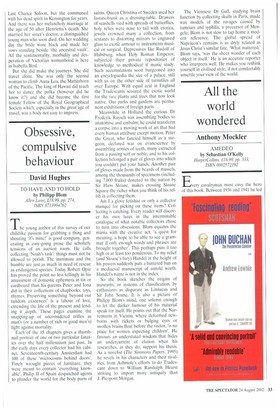From agony to ecstasy
Jane Gardam
LETTERS TO HENRIETTA by Isabella Bird, edited by Kay Chubbuck John Murray, £25, pp. 356,
ISBN 0719560470
This is a selection of the original letters written in the 1870s by the Victorian globetrotter, Isabella Bird, to her younger sister. Henrietta on the Isle of Mull. They were
posted from the USA, Australia, New Zealand, Hawaii, China and the Malay Peninsula. Henrietta edited them, it is thought heavily, and on her brief spells at home Isabella added to them and prepared them for publication by the great travel publisher, John Murray. They all turned into best-selling travel books.
Henrietta must have worked hard. The letters lie in their hundreds in the Murray archive, and elsewhere, travel-stained, torn, ill-spelt and ungrammatica, written at obvious speed from the craters of volcanoes and beside thundering rivers which Isabella had crossed clinging to her horse, and once clinging to the back of a swimming elephant. The handwriting is difficult and crossed on the page.
The blurb on this well-presented book — good map, notes and fascinating photographs — says that there is here revealed a different Isabella from the accepted stately traveller, very much the 'Lady' in the Rocky Mountains, the title of her most popular excursion. For example, she inveighs against the empire and the behaviour of its representatives but was too afraid to let these passages stand in the published text. Especially in her first round-the-world journey she rattles on with family gossip and indulges in sickly babytalk to Henrietta who, it is rumoured, she did not in fact get on with. Henrietta's photograph shows the kept-at-home clergyman's daughter, saccharine-pious. Isabel a has always been accused of making half her adventures up but the obvious speed at which these manuscripts were written suggests that they are 'unimproved', for there could hardly have been time.
Isabella Bird is not one of the 'important' travellers of her age. She was in no way an 'explorer'. Africa and the two Poles — the equivalent of space-travel today — were not for her. She did not stray far from where the English language could be found, and she expected and was given, thanks to the Church and the empire and the Foreign Service, wonderful British hospitality everywhere. Especially before Henrietta got her hands on the letters there are a freshness and enthusiasm that made for good entertainment.
She travelled in a sort of tireless ecstasy. Except for a dreary time in Melbourne with people very like the ones she had left behind in Edinburgh, and a mysterious, dark time in Japan when she probably destroyed her letters home, she is ebulliently energetic and delighted with herself. After a terrible voyage in a leaky steamship between Tokyo and Hong Kong she arrives to find the town on fire and immediately orders a palanquin to 'the English Bishop's Palace'. There she finds everybody fainting, and accompanies the Bishop down the Peak again to watch the fun. Riding along and astride her bronco, Birdie, across the Rockies in weather that had felled many strong men with frostbite along the way, she finds shelter at last and sits up half the night, talking.
This is the woman who, at home in Edinburgh, had been from childhood a permanent invalid suffering from an infectious, agonising carbunculosis of the spine. Until she was in her late twenties she was doped with bromide, opium and alcohol. All her teeth were drawn, all her hair fell out and she could not lift her head from the pillow without a steel brace until her desperate father suggested foreign travel. On board her first ship to America, she instantly recovered and was on the trot thereafter for the rest of her life, her symptoms only returning whenever she turned for home. She died in a nursing home at 73 with her trunks all packed and roped for China yet again.
By this time she was a legend. She took tea with the Queen, advised Gladstone on his foreign policy, held a salon in Kensington wearing Manchurian robes. She had grown very conceited, declaiming in very long sentences 'as if quoting from her books'. She was 4ft llin with a platform chest and fat. Her final passion was for photography, and we see her standing in a solar topee still six inches short of the lens of her tripod.
And there was the rather embarrassing business about the love of her life, the oneeyed, trigger-happy Rocky Mountain Jim, the right side of whose face had been removed by a bear, a man considered by the locals in Colorado to be the bore of the Last Chance Saloon, but she communed with his dead spirit in Kensington for years. And there was her melancholy marriage at the age of 50 after Henrietta's death. She married her sister's doctor, a distinguished young man who soon died. On her wedding day the bride wore black and made her vows standing beside 'the ancestral vault'. All the sentimentality, morbidity and desperation of Victorian womanhood is here in Isabella Bird.
But she did make the journeys. She did travel alone. She was only the second woman to climb Auna Loa, the Matterhorn of the Pacific. The king of Hawaii did teach her to dance the polka (however did he know it?) and she did become the first female Fellow of the Royal Geographical Society which, especially in the great age of travel, was a body not easy to impress.































































 Previous page
Previous page